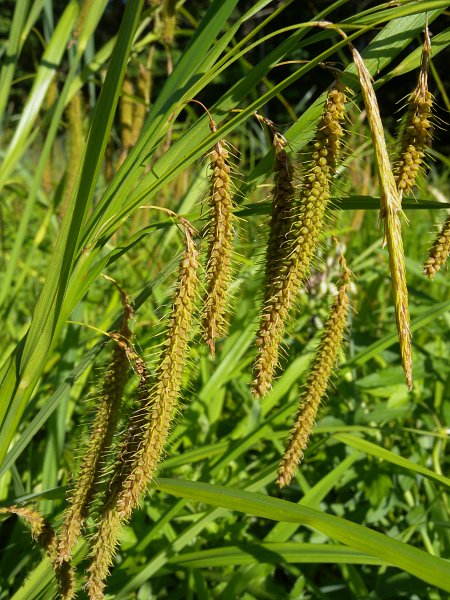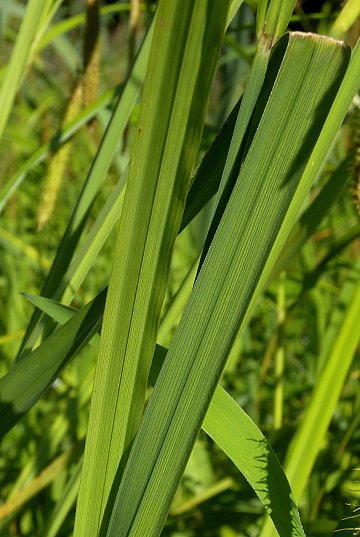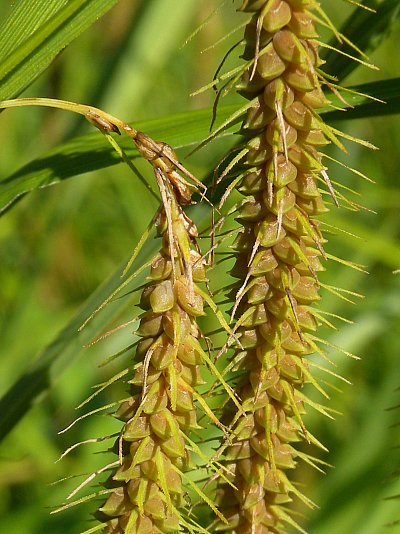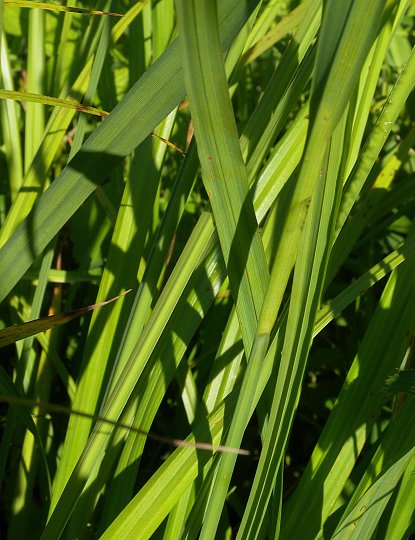
The staminate spikelets are ¾-4" long and very narrow; they are whitish green while immature, becoming tan at maturity. The pistillate spikelets are 1½-4" long and narrowly cylindrical; they are whitish green while immature, becoming bronze-colored at maturity. The peduncles of the staminate and pistillate spikelets are ¼-2½" long and glabrous. The perigynia are 2.5-4 mm. in length and 1.5-3 mm. across; they are broadly ellipsoid to obovoid, slightly flattened, glabrous, and veinless. Sometimes the perigynia are slightly crimped along one side. Each perigynium tapers abruptly to a minute beak from which the stigmata are exerted. The pistillate scales are 6-12 mm. in length; they have short oval bodies with long awn-like tips. Minute teeth occur along both sides of their tips. The oval body of each pistillate scale may be slightly indented near the base of the awn-like tip, otherwise its upper surface is jagged-truncate or rounded. The blooming period occurs from late spring to mid-summer, lasting about 1-2 weeks. The florets are cross-pollinated by wind. At maturity, the perigynia disarticulate from their spikelets, beginning at the tips; they have the capacity to float on water, distributing their achenes to new locations. The achenes are about 1.5 mm. long, obovoid in shape, and somewhat flattened; they are sometimes slightly crimped along one side. The root system is fibrous and rhizomatous. This sedge often forms colonies of plants.

Cultivation: The preference is light shade to full sun, wet to moist conditions, and soil containing loam, sand, clay, gravel, or peaty material. Some seasonal flooding is tolerated. This is a rather lanky sedge that leans to one side as the spikelets develop.
Range & Habitat: The native Fringed Sedge is occasional in southern Illinois, NE Illinois, and west-central Illinois, while in the rest of the state it is rare or absent (see Distribution Map). Habitats consist of a wide variety of wetlands, including prairie swales, sandy sloughs, sedge meadows, wet prairies, wet dolomite prairies, marshes, gravelly seeps, swamps, bogs, borders of small lakes, and ditches. This sedge is also found in damp areas of bottomland woodlands.

Faunal Associations: Sedges (Carex spp.) are ubiquitous in wetland areas and many insects are adapted to feed on them in these habitats. These species include leaf beetles (primarily Plateumaris spp.), Sphenophorus costicollis (Sedge Billbug), the seed bugs Cymus angustatus and Oedancala dorsalis, the shield bug Eurygaster alternata, aphids and leafhoppers, the spittlebug Philaenus parallelus, stem-boring larvae of the flies Cordilura varipes and Loxocera cylindrica, larvae of the shore fly Hydrellia griseola (Lesser Rice Leafminer), caterpillars of moths, caterpillars of skippers (Euphyes spp., Poanes spp.), caterpillars of the butterfly Satyrodes eurydice (Eyed Brown), and sedge grasshoppers (Stethophyma spp.). The Insect Table lists many of these species. Some vertebrate animals also use wetland sedges as a source of food. Ducks, rails, and other wetland birds feed on the seeds or spikelets (see Bird Table), while such turtles as Chelydra serpentina (Snapping Turtle) and Kinosternum subrubrum (Eastern Mud Turtle) feed on the spikelets or foliage (Ernst et al., 1994). Among mammals, muskrats eat the culms, roots, or sprouts of wetland sedges occasionally, while such mammals as the White-Tailed Deer and Black Bear feed on the foliage or spikelets very sparingly.

Photographic Location: A sandy ditch along a railroad at the Indiana Dunes National Lakeshore in NW Indiana.
Comments: Fringed Sedge is readily identified by its abundant drooping spikelets and the bristly appearance of those spikelets from the awn-like tips of the pistillate scales. It is a rather variable species across its range and different varieties have been described. In Illinois, the typical variety, Carex crinita crinita, is the most common by far. Another variety, Carex crinita brevicrinis, has been found in southern Illinois, where it is rare. This latter variety has larger perigynia, shorter tips on its pistillate scales, and achenes that are never crimped along one side. Another variety, Carex crinita gynandra, has been found in southern Illinois recently, where it is rare. Sometimes this variety is regarded as a distinct species, Carex gynandra (Fringed Look-Alike Sedge). This variety (or species) differs from the preceding varieties of Fringed Sedge by its pistillate scales: the bodies of these scales are more narrow (ovate or lanceolate in shape) and they taper gradually to their awn-like tips, instead of tapering abruptly by forming indentations or jagged-truncate upper surfaces (see Mohlenbrock, 1999/2011, for more detailed information).